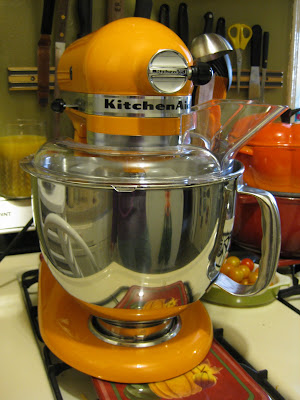This is ALL THINGS CONSIDERED. I'm Noah Adams.
Last Friday, you'll recall we heard about 216,000 jobs disappearing, that's what the Labor Department said. Some people were encouraged, saying the number could have been higher. We thought we'd take a look here, on Labor Day itself, at one product still being made in the U.S. in a factory still running three shifts. It is the KitchenAid stand mixer.
This is the big, heavy one, $200 and up, an investment both in money and in your counter space.
(Soundbite of mixer)
It may be surprising to learn that this mixer and all the KitchenAids all over the world, they all come from Greenville, Ohio. That's a small town in West Ohio, pretty close to Indiana. The KitchenAid factory has been open there since 1941. I went out to take a look, but I stopped first in downtown Greenville, where the company has a retail store. It's called the KitchenAid Experience Center. You'll see every model of mixer and blender in every color. People come for cooking demonstrations. Sometimes, customers arrive as if on a pilgrimage, walking through the front door in amazement.
Downstairs, there's a mixer museum, featuring, especially now, a cobalt blue K5A model that was owned and used and signed by Julia Child. Bon appetit, she inscribed on the bowl. Fifty or so other vintage mixers have been donated, and here's an example of the very first. Store manager Gloria Keller-Brinley shows me the 1919 Model H.
Ms. GLORIA KELLER-BRINLEY (Manager, KitchenAid Experience Center): It stands, oh, I would say, relatively 24, 26 inches high, and it weighs approximately 65 pounds, and they were made four per day, and the average cost was $189, which was equivalent to about $2,000 today.
ADAMS: That was 1919. Ten years before that, an engineer, Herbert Johnson, had invented the mixer idea for bakeries. He made the Hobart. It held 80 quarts, and then came the five-quart countertop concept.
Ms. KELLER-BRINLEY: They didn't know what to name it, so they took several of them home: the CEO and the vice president and the engineers, and one wife was particular on it by saying it was the best kitchen aid she's ever had — I don't care what you call it.
ADAMS: The KitchenAid factory is on the outskirts of town, a modern building, long and low and vast. You can't see it all at once. About 700 people work here, making the mixers and the KitchenAid blenders, as well. It is largely an assembly process: Parts come in from all over and leave together in boxes ready for the stores. KitchenAid's Sarah Erisman walks me through the factory.
Ms. SARAH ERISMAN: You can see that they're loading parts onto the line. They're getting ready to go into the paint room. The parts that they're loading right now are called pedestals. They're going to be going through a wash, a rinse and a dry before it actually goes into the paint booth to get painted, and we're going to go in and see a little bit more of that.
ADAMS: You recognize some of the glossy enamel colors: empire red, onyx black, pearl metallic, licorice. White is the one I can name; it's just the white; And you recognize the parts: the pedestals we saw getting set to ride through the paint room and especially the part that KitchenAid refers to as the wire whip. I call it a whisk. They're being made here by Sherry Wopplehorse(ph).
Ms. ERISMAN: What you see Sherry doing here, looks like that's the five-quart wire whip. She is putting the wires in her shank, pressing on her pedal there, and it actually crimps that wire into the shank and locks it in there.
ADAMS: You did that in less than a minute.
Ms. SHERRY WOPPLEHORSE (Worker, KitchenAid): We have to do 600 in eight hours. So yeah, we have to do them pretty quick.
Mr. TONY MIKESELL(ph) (Worker, KitchenAid): I've been doing this job for almost 17 years.
ADAMS: Tony Mikesell, local guy, four years in the Army, back home to KitchenAid. He has a couple of lathes at his work station. And during his shift each day, Tony will process 5,000 parts.
Mr. MIKESELL: I machine down the hub gear that's in the nose of the mixer for all the attachments and stuff to go into and also face off the back of a couple gears so they mesh correctly in the transmission housing.
ADAMS: The KitchenAid factory seems to run without effort. A worker will pick up a part that has just arrived, and where it makes sense, robotic machines do even faster and more precise work. The question comes up: how many stand mixers does the company make here? KitchenAid won't say, really, but Sarah Erisman offers an estimate.
Ms. ERISMAN: During our busy season, we have been known to build around 7,000 units a day, mixers a day, but that's during our really high-peak, busy season. I'm not sure where our schedule is right now. It just depends on demand, you know? With the economy being like it is, you know, it could be a little lower than that.
ADAMS: Late summertime brings the Great Darke County Fair, permanent fairgrounds right there in Greenville.
(Soundbite of county fair)
ADAMS: KitchenAid is a big company now owned by Whirlpool. Whirlpool has annual sales of $20 billion. A tiny portion goes to help out the local county fair. KitchenAid sponsors the 4-H Club Teen Bake-a-Rama.
(Soundbite of mixer)
ADAMS: Four young people are in the competition, using hand mixers to whip up brownie butter, hoping for the judges' delight.
Unidentified Woman: This one looks great. This one looks great. This one fell apart. Either he underbaked it, or he tried to pull it out of the pan too soon.
(Soundbite of county fair)
Ms. ALEX NEIKAMP (4-H Club Teen Bake-a-Rama): Our first place goes to Sara Carroll(ph).
(Soundbite of applause)
Mr. NEIKAMP: Thank you all contestants for competing, and we ask that you stay after for pictures. Thank you.
(Soundbite of applause)
ADAMS: Alex Neikamp hands out the prizes. Neikamp is 17. Usually, he enters the contest. This year, he's helping run it. He has been baking since grade school, growing up with a KitchenAid mixer on the counter in his family's kitchen.
Mr. NEIKAMP: That's probably my favorite utensil in my kitchen. I especially like to make lemon meringue pie on it because you can make your crust, your filling and your meringue all in one.
ADAMS: So in the years to come, when you're out on your own with your own kitchen, what's going to happen to that mixer? You're not going to get to take it with you.
Mr. NEIKAMP: Well, I'm hoping when I get married that I'll get one for a wedding present.
ADAMS: Alex Neikamp, talking with us at the Great Darke County Fair. He's a 4-H Club member, a home baker who will someday own a KitchenAid stand mixer, made in his home county, the small town of Greenville, Ohio.
(Soundbite of music)
I'm Noah Adams. You're listening to ALL THINGS CONSIDERED from NPR News.
What's your most valued home or kitchen tool? Please tell me about it in a comment on the blog.









































































